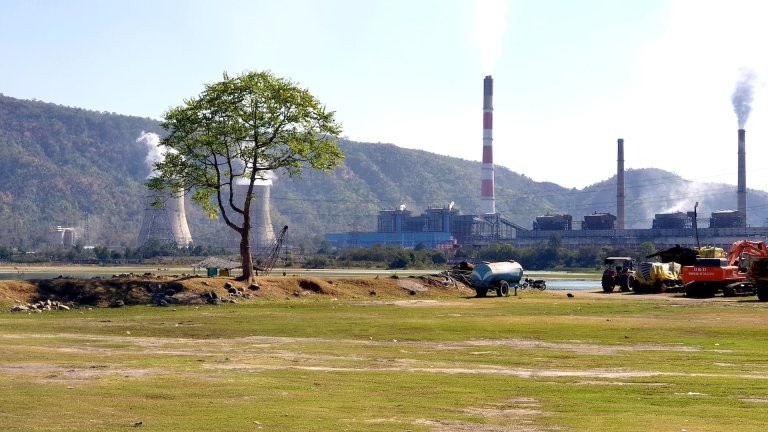- About
- Topics
- Story
- In-Depth
- Picks
- Opinion
- News
- Donate
- Signup for our newsletterOur Editors' Best Picks.Send
Read, Debate: Engage.
Going into COP27, has India delivered on its five-part green pledge from last year’s COP in Glasgow? Are Prime Minister Modi’s projections achievable for a country of 1.3 billion that is still largely dependent on fossil fuels?
During COP27, small island nations called for India to pay into a climate compensation fund to assist developing countries for loss and damage. The move marks the first time small island nations have held India accountable for its carbon emissions.
While Indian leader Narendra Modi is absent at this year’s COP, he nonetheless made a series of promises just a year ago, committing to a net-zero target emissions for India by 2070. It should be noted that while India is currently the third-biggest carbon emitter, its sizable population renders its per capita emission much lower than that of the US, China and the EU.
"First, India will increase its non-fossil energy capacity to 500 gigawatts by 2030," Modi said at last year’s COP26. "Second, India will fulfill 50 percent of its energy requirements from renewable energy sources by 2030.
"Third, between now and 2030, India will reduce its projected carbon emissions by 1 billion tonnes. Fourth, by 2030, India will reduce the carbon intensity of its economy by 45 percent. Fifth, India will achieve the target of net zero by 2070."
Modi further added that these five elixirs will constitute "an unprecedented contribution by India towards climate action."
But while Modi’s bombastic statements portray an India set to effectively reduce its emissions, an economic survey released by his own government reveals otherwise.
The survey, which covers the 2021-22 period and was released by India’s Ministry of Finance, found that by 2030, the demand for coal is expected to reach the range of 1.3-1.5 billion tonnes. This highlights an increase of 63 percent from the 2019-20 demand, which was 955.26 million tonnes.
As India’s dependence on coal will increase, the survey predicts, so will the emission of greenhouse gases. According to a University of South Florida research titled Estimates of Emissions from Coal Fired Thermal Power Plants in India, the roughly 67 thermal power stations using coal and lignite - which are responsible for generating over 70 percent of India’s electricity - release 1.3 billion tonnes of carbon dioxide equivalent annually, or about one-third of all greenhouse gas emissions in the nation.
Furthermore, the central government has permitted private coal mining, touting the move as one of its most comprehensive reforms of the industry. The government hopes that it will increase coal industry productivity and competition, and thus draw capital and world-class technology and support job growth.
28 coal mines have been auctioned off so far. Of these, 27 were sold at auction to private businesses. There are currently 88 coal mines up for auction.
However, Dr Ravindra Khaiwal, professor of environment health at the Centre of Excellence on Climate Change, believes that the transition to renewable energy will take some time.
"India has taken extensive steps to move towards its goal of achieving net zero emissions by 2070," Dr Khaiwal told FairPlanet. "We are focusing more on renewable energy like solar power in order to meet our energy demands, but we need to understand that this transition will take some time and we will be able to meet our goal."
He added that the country's local pollution will also increase as a result of the coal freeway. The government in the economy survey informed that thermal coal power plants will meet the new emission standards. However, the actual implementation will take a few more years to complete.
With the exception of government-run and a few private plants, the majority of the industry still hasn't attempted to adhere to the standards.

A thermal power plant producing electricity in Sarni, Madhya Pradesh, India. ©sheikh sohel
Another pledge made by India at COP26 was switching to renewable energy in order to meet its target of 500 gigawatts of installed capacity through non-fossil fuels and 50 percent of its energy requirement from renewables by 2030.
Currently, this capacity stands at 105.8 gigawatt (GW) and the government has a five-year plan to add 5,560 megawatts of renewable energy capacity with significant carbon offset potential.
Even if Delhi would be able to meet this target, this would constitute but 1 percent of what Modi promised COP26.
Despite falling short of its COP206 pledges, India is taking steps to shift to renewable energy sources and reduce carbon emissions.
The public sector units (PSU) that produce coal and lignite assert that small actions taken by them, including afforestation and shifting to cleaner energy in small phases to minimise their carbon footprints, are "milestones" in the direction of a cleaner economy.
According to the 2021-22 economic survey, the PSUs covered 56,000 hectares (ha) of land by 2020–21, resulting in a carbon sink of around 500,000 tonnes of CO2 equivalent per year.
By planting roughly 75 million trees by 2030, it plans to cover an extra 30,000 acres of land - in and around coal mining sites - with vegetation. The government claimed that by afforesting around 150,000 hectares, or nearly one-third of Delhi, it will reduce CO2 emissions by 0.04 percent per year for India.
Critics point out, however, that relying on afforestation as a path to net zero in a country with a high population density may not be particularly successful.
Furthermore, the government has increased the budget expenditures of the government-run Indian Renewable Energy Development Agency (IREDA) and Solar Energy Corporation of India (SECI) by 143 percent, totaling Rs 28,570.99 crore, in keeping with India's pledge.
The Centre has also created a "society" under the Ministry of Electricity that seeks to act as the main policy advocacy organisation for the power and associated sectors, helping governments and businesses with the transition to a more energy-efficient economy.
As countries have been urged to provide updated green targets at COP27, Modi is expected to address environmentalists’ concerns.
Image by Ravi Sharma.
